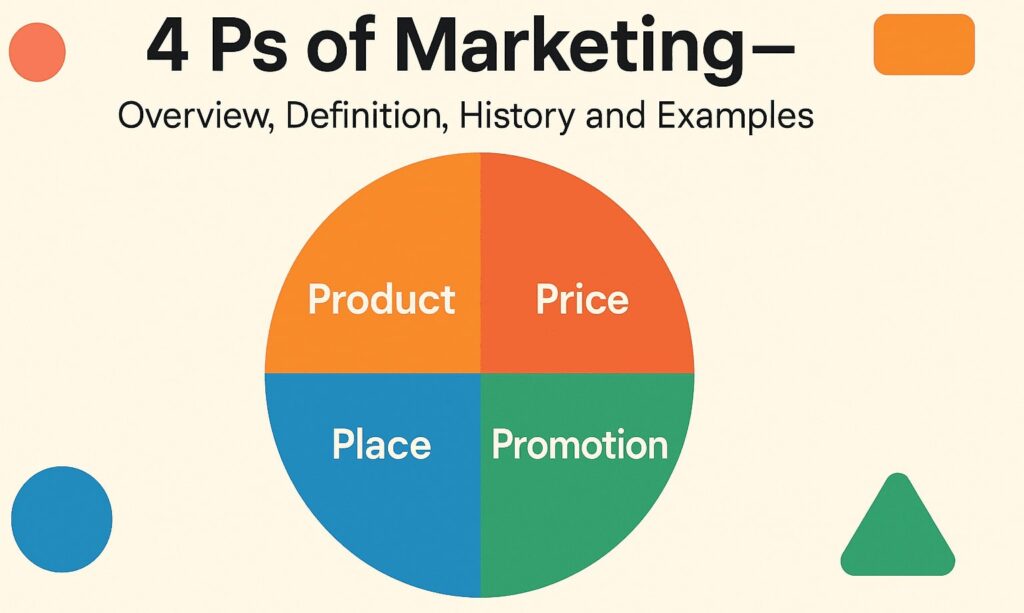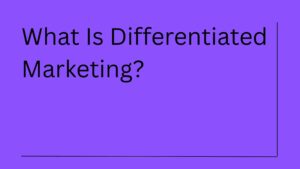Marketing, when stripped down to its most fundamental building blocks, comes down to a simple, almost elegant framework: the 4 Ps. Product. Price. Place. Promotion. You’ve probably heard of them. Maybe in a textbook. Maybe in a boardroom. Or maybe as a passing reference on a podcast.
But the truth is, the 4 Ps aren’t just theory—they’re still very much alive in the way real businesses craft their strategies, position their offers, and fight for relevance in a noisy world.
So let’s not just define them. Let’s unpack about 4 Ps of Marketing, challenge them a little, and see how they show up in the world around us.
History of the 4 Ps of Marketing
The 4 Ps were introduced in 1960 by E. Jerome McCarthy, an American marketing professor who wanted to simplify how people approached marketing strategy. His goal was to create a structured way for businesses to think about their market offerings.
But here’s the thing: it didn’t start in a vacuum. The concept built upon earlier marketing thought, particularly the “marketing mix” idea from Neil Borden in the 1940s, which included 12 elements like branding, display, and distribution. McCarthy condensed it into four powerful levers, making it easier to teach and apply.
And even though it came from the Mad Men era, the 4 Ps have managed to stay oddly relevant, even in today’s digital-first, AI-assisted world.
What Are the 4 Ps of Marketing? (A Quick Definition)
The 4 Ps of marketing are the core elements businesses use to bring a product or service to market. Introduced by E. Jerome McCarthy in the 1960s, this framework still serves as the skeleton of most marketing strategies.
Here’s the breakdown:
- Product – What are you selling?
- Price – How much does it cost, and why?
- Place – Where do customers find it?
- Promotion – How do you tell people about it?
It sounds basic. But just like a great recipe, these ingredients can be simple—yet complex when combined with real-world variables like buyer behavior, trends, technology, and competition.
1. Product – The Heart of the Strategy
Let’s be honest: marketing doesn’t work without something worth marketing. The product is your offer. It’s what solves a problem, fills a gap, or brings joy.
What Counts as a Product?
A “product” can be:
- A physical item (like a smartwatch)
- A digital solution (like a subscription-based design tool)
- A service (like a personal stylist or cloud consultant)
- A hybrid (think Uber: app + service)
What matters is not just what it does—but how it’s positioned. Is it premium? Budget-friendly? Is it the fastest? The safest? The most ethical?
Your product is a story waiting to be told. And good marketing starts by understanding exactly what you’re offering, to whom, and why it matters.
Real-World Example
Take Apple’s iPhone. It’s not just a phone—it’s a status symbol, a productivity tool, a content creation device, a lifestyle statement. The product itself is layered. Apple doesn’t market features, they market feelings—and they refine their product to match that emotional brand promise.
Key Product Decisions:
- Features and design
- Branding and packaging
- Variants or editions
- User experience and after-sales support
Even something as small as the way your packaging feels in hand can influence perception. People don’t just buy products. They buy experiences.
2. Price – More Than Just a Number
Price is about money—but also about perception. It’s what your product is worth in the eyes of your target audience. And the price you choose sends a message.
What Does Price Really Say?
It says:
- “This is premium and exclusive”
- “This is affordable and practical”
- “This is competitive and fair”
The number you put on your product doesn’t just affect margins—it shapes your audience’s expectations. A $5 t-shirt and a $150 t-shirt both cover your body, but they’re not playing in the same mental category.
Common Pricing Strategies:
- Penetration pricing – Low initial price to enter a competitive market
- Skimming – High initial price, then gradual reduction
- Psychological pricing – $9.99 feels cheaper than $10
- Freemium – Free basic service, paid upgrades (popular in SaaS)
Real-World Example
Think about Netflix. Their pricing has evolved over the years—not just based on costs, but based on content offerings, regional competition, and user demand. They offer tiers: ad-supported, standard, and premium. It’s not just “how much?” but “what experience are you buying into?”
3. Place – Where Access Meets Strategy
“Place” in marketing isn’t just a location—it’s how your product gets to the customer. It answers the question: where can your audience find you?
And today, that might be:
- A shelf in a physical store
- An Amazon listing
- A Shopify site
- A mobile app store
- A Zoom link or client dashboard
Place = Accessibility + Convenience
It’s about meeting people where they are. If your customer base is digitally native, being offline is a missed opportunity. If you’re selling local, then online-only might not cut it.
In short: distribution matters.
Real-World Example
Starbucks doesn’t just sell coffee—it sells accessibility. On every other block, in airports, grocery stores, and even inside Target. That’s “place” strategy: ubiquity. You don’t have to go out of your way to find Starbucks—it’s already in your path.
Key Place Decisions:
- Physical store vs. online
- Direct-to-consumer (D2C) or third-party retailers
- Wholesale or distribution partnerships
- Region-specific strategies
With the rise of omnichannel retail, “place” has become a moving target—but the goal stays the same: reduce friction.
4. Promotion – Getting the Word Out (Strategically)
This is the most visible of the 4 Ps. It’s where your brand takes the stage and says, “Hey world, here’s what we’ve got!”
Promotion isn’t just ads. It’s storytelling. Messaging. Timing. And choosing the right channels to create awareness, interest, and action.
What Counts as Promotion?
- Paid ads (Google Ads, Facebook, LinkedIn, etc.)
- Content marketing (blogs, video, SEO, podcasts)
- Email marketing
- Influencer campaigns
- Trade shows or PR efforts
- Social media
Promotion is often what separates good products that fail from average products that win. It’s the bridge between potential and performance.
Real-World Example
Dollar Shave Club launched with one video on YouTube—clever, punchy, and unforgettable. That single video helped the brand explode into a multi-million-dollar business. The product was solid, yes. But it was the promotion that sparked momentum.
Promotion Strategy Tips:
- Know your audience’s media habits
- Tailor the message to the channel
- Don’t sell—connect, educate, entertain
- Use storytelling, not just sales copy
A great promotion strategy isn’t about shouting the loudest—it’s about resonating the deepest.
How Do the 4 Ps of Marketing Work?
You don’t just “set and forget” your 4 Ps—they’re meant to respond to market forces. You tweak them depending on your target audience, market trends, product lifecycle, or even seasonality.
For example:
- If demand dips, you might lower price, offer bundled products, or run a promotion.
- If you’re going premium, you might change your place (exclusive stores), raise price, and adjust promotion to focus on luxury.
- Launching a new product? You might go with introductory pricing, heavy promotion, and choose channels (places) that ensure visibility.
In practice, it’s more fluid than formulaic. But the structure helps you make smart, strategic decisions—especially when things get noisy or unclear.
Here’s the catch: none of the 4 Ps live in a vacuum. They’re interconnected, and tweaking one affects the others.
Let’s take a fictional example:
You launch an eco-friendly backpack.
- Product – Recycled materials, waterproof, minimalist design
- Price – Slightly premium due to sustainability
- Place – Sold online only, targeting urban millennials
- Promotion – Instagram influencer campaigns and YouTube gear reviews
Now imagine you switch to selling in Walmart. That changes your place, which might force you to adjust your price, which could affect how you present your product, and alter your entire promotion approach.
That’s how delicate this balance can be.
Examples of the 4 Ps in the Wild Advertising
Here are a few more real-world brands using the 4 Ps in clever ways:
Nike
- Product – Athletic wear and lifestyle branding
- Price – Mid-to-premium, with limited-edition drops at higher tiers
- Place – Global stores, eCommerce, mobile app
- Promotion – Story-driven ads, athlete endorsements, emotional narratives
Spotify
- Product – Music streaming with personalization
- Price – Freemium with premium upgrade
- Place – Mobile, desktop, smart devices
- Promotion – Wrapped campaigns, targeted ads, student discounts
IKEA
- Product – DIY furniture that’s functional and affordable
- Price – Low to mid-range, built on volume
- Place – Massive physical stores and a growing online presence
- Promotion – Catalogs, AR tools, lifestyle ads
These companies don’t randomly market—they engineer the 4 Ps to support their positioning, customer experience, and long-term growth.
How to Use the 4 Ps of Marketing in Your Marketing Strategy
Here’s how the 4 Ps show up when you’re actually building a strategy:
- Start with your audience. Understand their needs, preferences, and pain points.
- Define the product. What problem does it solve? What makes it unique?
- Set a pricing model. Consider value, competition, and positioning.
- Choose your distribution. Online, offline, or hybrid? Global or local?
- Develop promotional tactics. Tailor your message to the right channels.
This model also works beautifully for product launches, rebrands, and campaign planning. It’s not about being old-school—it’s about being structured in your thinking so you can flex creatively where it matters most.
Why Is It Also Named the Marketing Mix?
That term—“marketing mix”—predates the 4 Ps. It was coined in the 1940s to describe the blend of tactics a business could use to achieve its goals. The word “mix” makes sense—it implies customization, tweaking, fine-tuning.
McCarthy’s 4 Ps became the most common version of the marketing mix, which is why the terms are often used interchangeably. You’ll hear marketers say things like:
“Let’s revisit the marketing mix before we scale.”
Or:
“We need to rebalance the 4 Ps based on customer feedback.”
It’s the same cake. Just different names for the ingredients.
What’s the Difference Between the 4 Ps and the 4 Cs of Marketing?
In the 1990s, marketing strategist Robert F. Lauterborn proposed the 4 Cs as a customer-focused evolution of the 4 Ps. Here’s how they align:
| 4 Ps | 4 Cs |
| Product | Customer |
| Price | Customer Cost |
| Place | Convenience |
| Promotion | Communication |
The 4 Cs flip the perspective from business-first to customer-first:
- Instead of asking “What are we selling?”—you ask “What problem are we solving?”
- Instead of “What’s our price point?”—you think “What will this really cost the user?”
That doesn’t make the 4 Ps outdated—it just means marketers today often blend both perspectives. You need the structure of the 4 Ps and the empathy of the 4 Cs to market effectively.
The Four Ps Are Essential for Marketers
Let’s get real: no serious marketing strategy exists without at least touching the 4 Ps. You can call them outdated or traditional—but they still form the backbone of everything from:
- Launching a new app
- Running an email campaign
- Building a pricing page
- Designing an in-store experience
Think about it: even TikTok creators working with brands consider product placement (Product), platform reach (Place), ad spend (Price/Promotion), and messaging hooks (Promotion again).
Whether you’re a freelancer, CMO, startup founder, or side hustler—the 4 Ps help you get back to the basics when things feel overly complex.
Additional Marketing Mix Concepts
Over time, people have expanded the original 4 Ps into broader frameworks:
The 7 Ps of Marketing
This includes:
- People – The human side (staff, support, experience)
- Process – How the service is delivered
- Physical Evidence – Tangible elements (storefronts, uniforms, reviews)
This is especially helpful for service-based businesses where the “product” isn’t tangible.
The SAVE Model
A more modern take, especially for B2B and SaaS:
- Solution (instead of Product)
- Access (instead of Place)
- Value (instead of Price)
- Education (instead of Promotion)
SAVE focuses more on solving pain points and nurturing leads—something the classic 4 Ps don’t emphasize as clearly.
The STP Model
While not technically part of the mix, Segmentation, Targeting, and Positioning often come before defining your 4 Ps. It ensures you’re designing your mix for the right audience.
Are the 4 Ps Still Relevant Today?
Yes—and no.
The fundamentals are timeless. But the world has changed.
Today, marketers often refer to expanded models:
- The 7 Ps (adding People, Process, Physical Evidence)
- The 4 Cs (Customer, Cost, Convenience, Communication)
- The S.A.V.E. model (Solution, Access, Value, Education)
These frameworks attempt to reflect more customer-centric, digital-age thinking. And that’s fair. But even then, the original 4 Ps are still hiding underneath.
They may evolve in how we talk about them, but not in the roles they play.
Final Thoughts
The 4 Ps of marketing might seem basic on the surface—but in practice, they’re anything but simple. They force you to ask hard questions:
- What’s your product really solving?
- Are you priced for profit—or perception?
- Can your customer find you without effort?
- And are you promoting your message in a way that actually sticks?
Great marketing doesn’t happen by accident. It happens when businesses deliberately shape these four levers to craft strategies that speak, solve, and scale.
So before chasing the next trend or shiny tool, pause. Revisit the 4 Ps.
Because sometimes, the oldest frameworks still deliver the clearest answers.
FAQs About the 4 Ps of Marketing
Absolutely. In fact, the 4 Ps offer small businesses a clear, low-cost way to build strategy. You don’t need a big ad spend to optimize your product fit, refine pricing, choose smart sales channels, and promote through organic methods like social media, partnerships, or content marketing.
Yes, and here’s why: while tools and technologies evolve, the core decisions marketers face remain the same. AI can suggest a price or write ad copy, but you still need to set product positioning, define pricing strategy, choose platforms, and align your messaging.
They can—and should. While services are intangible, you can still define what you’re offering (product), how much you charge (price), how clients access it (place), and how you promote it. Many also use the expanded 7 Ps to include people, process, and physical evidence.
Ideally, every time something shifts—new competition, market feedback, changing customer behavior, or even internal changes like product updates or pricing models. Reviewing your 4 Ps quarterly or semi-annually keeps your strategy grounded and adaptive.
Definitely. The 4 Ps provide a shared language and decision-making framework that bridges departments. Marketing defines what the brand promises, sales aligns on delivery, and product ensures features match the pitch. It’s a tool for clarity across functions—not just campaigns.






2 thoughts on “4 Ps of Marketing—Overview, Definition, History and Examples”
Hello mate, now I know these four elements are the key components of a marketing strategy at every level. Made to be used effectively to market a product or service to the target audience effectively.
This blog felt like a pure and great one to read, with better content that particularly brings marketing to the table. Thanks for bringing excitement; online is cool.